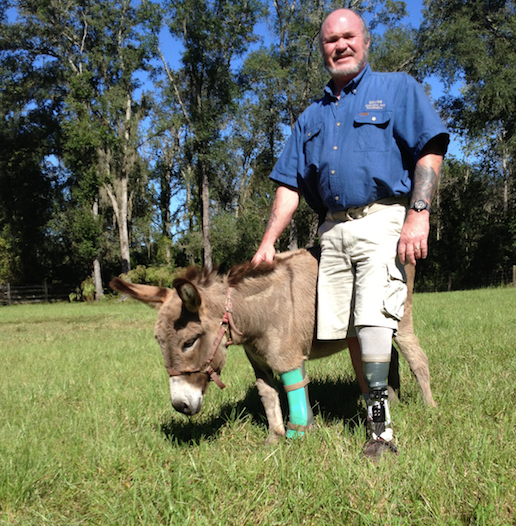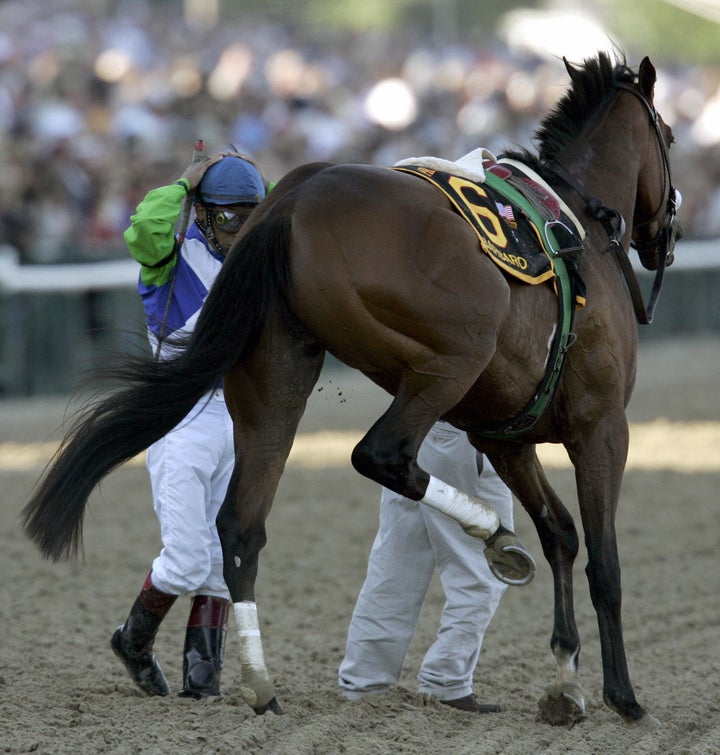
Four years ago, Phil Yarbrough’s horse Mercedes broke her leg and ripped apart her knee while running in her pasture outside Atlanta.
"She went over a hill, and she did not come back up," Yarbrough said.
Conventional wisdom suggests that horses with broken legs can't be saved. Hundreds of racehorses with injured limbs are euthanized each year. In June, a horse named Helwan was euthanized after he broke a bone on the same track where, hours later, American Pharoah won the Triple Crown
But Yarbrough wasn't willing to consider this fate for his horse.
"She's like a kid to me," he said.
Veterinarians at the University of Georgia operated on Mercedes' leg. Yarbrough remembers that the doctors gave the Arabian horse a 30 percent chance of recovery before the operation to put titanium plates in her shattered appendage. A little way into the nine-hour procedure, the surgeon came out to say that the odds might be even lower.
Yarbrough was asked if he wanted to euthanize Mercedes. He recalls being worried that keeping her alive might be "selfish." Still, he opted to go on with the surgery.
For the next year, Mercedes was in and out of the hospital, recovering from the surgery and then dealing with hard-to-treat infections and a couple of bouts with a serious inflammatory disease called laminitis.
Yarbrough and his wife Christine came to visit, bringing their horse bags of clover.
Before Mercedes' release, Yarbrough was concerned that her leg hadn't yet completely healed and that it would be prone to another injury unless she was essentially confined to a stall for the rest of her life.
Yarbrough wasn't willing to consider confinement. So he went looking for another option. That's how he met Ronnie Graves.

Ronnie Graves with his donkey, Luigi.
Graves, who runs VIP Veterinary Inclusive Prosthetics and Orthotics in Florida, is among a growing number of people who have dedicated their careers to helping horses recover from injuries that were once considered fatal.
Graves, who wears a prosthetic limb himself (he lost his left leg in a factory accident about 40 years ago), didn't always work with horses. He began by making prosthetics for humans, even inventing a waterproof "sleeve" that makes the devices look more lifelike. But in 1997, a neighbor who knew about Graves' work with humans asked him to take a look at her horse Scarlett.
Scarlett had torn her knee apart stepping in a hole. Her owner had been advised to euthanize her.
"She refused and instead had her in a sling, chiropractic care, acupuncture, for a year," said Graves, who agreed to make Scarlett a knee brace.
Word spread about Graves' unconventional work. He was asked to help out with an elephant, an alpaca and a friendly steer named Dudley.
Graves estimates that he’s made 30 to 40 prosthetic limbs and orthotic braces for horses in the years since Scarlett first limped into his life. Some are pets. One was a champion jumper.
A horse named Star had been so severely neglected by her previous owners that her growing hooves had twisted up into her ankles, which were wrecked. Veterinarians estimated that she'd been hobbled like that for as long as three years, unable to walk, confined to a stall.
"Everybody's like just put her down, don't mess with it, why bother, that kind of thing," recalled Dani Horton, founder of Hope Equine Rescue, which assumed Star's care when a relative of the owners intervened.
Horton didn't want to take that option. "I felt that she deserved a chance," Horton said, and she went in search of someone who might be able to help Star walk again. She found Graves.
"[The horse's] right front leg was bowed backwards at the fetlock and fixed," Graves said. "I made a device that would bring her back up to a level height and transfer her weight bearing. Her left front just needed to be supported from being required to carry her weight."
Star lived for another year, able to walk, able to graze. She died from an infection in her bone that "started to deteriorate what good bone she had left," Horton said. "Unfortunately, the years of neglect and damage finally caught up to her."
A year might not sound like a long time. But it was worth it.
"We got to see her run wearing her devices. And we saw her walk and graze for the first time in three years," Graves said.
"She was happy. She was a happy pony," Horton said. "We were able to give her a good year of life."
Most horses with serious injuries aren't as lucky as Graves' patients. Between 700 and 800 horses die at U.S. racetracks each year, according to multiple sources.
Patrick Battuello, who keeps a watchdog website called Horseracing Wrongs, said the true number could be even higher.
"I have 966 confirmed deaths in 2014," Battuello told The Huffington Post. "That figure can reasonably be doubled. My best guess is that 2,000 racehorses die either racing or training on U.S. tracks each year. The majority -- perhaps 80 percent -- do indeed die from leg injuries."
There are lots of reasons given for why leg injuries lead to this grim outcome so often.
Although it is possible to get insurance for racehorses that covers surgery, "mortality insurance," which pays out if the horse dies, is more common, said Michael Levy, president of the equine insurance agency Muirfield Insurance.
So most horse owners end up paying out of pocket for medical treatment. Horse surgery isn't cheap. The full treatment can run from $5,000 to $20,000, plus the cost of any prostheses. Graves said that braces and prosthetics usually run a few thousand to design and make. Yarbrough said Graves made Mercedes a green brace as a nod to how much money he'd spent on her treatment.
Nor is every horse a good candidate for this kind of care. Success requires a large commitment on the part of the horse's caretaker, who can't just put on the artificial limb or brace and be done with it, but must follow a time-consuming regimen that allows the horse to acclimate to the new situation.
The horse, too, has to be amenable.
But the most salient reason so many injured horses are euthanized is that so few people are trying to save them -- and so few horse owners and trainers know they have a choice.
Trainer Mark Casse, whose horse Danzig Moon was euthanized this past spring after breaking a leg during a race, told HuffPost that he didn't know horses could get prosthetics.
"I haven’t even heard of it," he said. "Of course I would try it. I’m always open to anything, especially if there’s a shot of saving a life. I really don't know why anyone would resist."

Kentucky Derby winner Barbaro broke his leg at the first turn of the Preakness Stakes in May 2006. Despite surgery and months of treatment, complications led to the horse being euthanized in January 2007.
Graves isn't alone in his specialty. For several decades, equine veterinarians Barrie Grant and Ted Vlahos have been lecturing and publishing and trying to get the word out about the feasibility of orthotic braces for horses whose legs aren't beyond repair and the possibility of amputation and artificial limbs for others.
Vlahos thinks these sorts of treatments could be especially successful with injured racehorses, which are otherwise in peak physical shape.
As far back as 1985, the Los Angeles Times was writing about Grant's work with injured thoroughbreds. Grant himself thinks the use of amputation with horses dates back even further, having "found some really good descriptions of the technique in a text book dated 1902."
"Taking the leg off a horse is not something that most owners can even contemplate," Grant told DVM360, a veterinary trade magazine, in 2002.
It doesn't always seem like a lot has changed since.
"People just can't imagine the horse can get around on a prosthesis," Grant said, adding that a common feeling is, "And you can't really ride them anyway, so what's the point? There's a lot of horses around, so what's the point? Other than horses like to be alive."
But Graves, Grant and Vlahos are slowly changing minds. Niki Marie Hansen,a veterinary prosthetist who is finishing up her Ph.D. in veterinary science at Louisiana State University, hopes to follow their lead.
Asked how many horses that now would be euthanized due to leg injuries she thinks she could save, Hansen said, "I'd like to say all of them, but that's the dreamer in me talking."
"I would like a chance to work with all of them," she added. "I'm not doing this for recognition. I do this because I love them and believe that they deserve to live comfortably despite debilitating injury."
Policymakers are also paying greater attention to racehorse deaths and injuries. A new coalition of politicians, jockeys, horse owners and animal welfare groups -- including the Humane Society of the United States -- is advocating for increased transparency about and regulation of the drugs administered to racehorses. And in mid-July, Reps. Andy Barr (R-Ky.) and Paul Tonko (D-N.Y.) introduced the Thoroughbred Horseracing Integrity Act, an anti-doping measure. (That bill contains a startling figure for how much money horse racing supposedly contributes to the U.S. economy: $25 billion a year.)
But racetrack veterinarian Jeff Blea said most current efforts are aimed at injury prevention, not treatment.
Although more horses are surviving racetrack injuries, Blea is still skeptical about prosthetics, citing the usual reasons, including the risks of infection and laminitis, as well as the fact that "getting that thousand-pound animal to get up and down and be mobile on that device is a very difficult thing to do."
"We can't repair all of them," he said. "It's more humane to try not to save those animals where it's not going to be a good outcome."
But even with this more bearish take, Blea said he thinks it's possible that the use of prosthetics -- as an alternative to euthanasia -- could expand.
"I would agree that most folks are unaware of the possibilities and limitations of prosthetic devices in horses. ... Perhaps with some good press, equine prosthetics may become more commonplace," he said. "Anything's possible."

Phil Yarbrough with his horse Mercedes.
Mercedes is still living with Yarbrough and his wife. She just turned 16. She still wears a brace that Graves designed for her.
"Without the brace, she is basically confined to stall duty only. The brace gives her the freedom to run, graze and enjoy pasture mates," Graves said.
Yarbrough describes Mercedes as smart and "sophisticated." She likes to give kisses in exchange for treats and she enjoys her life.
"She runs with this broken leg and you can hardly tell," he said.
Mercedes has a new pasture mate, an adopted horse named Serenity. A 19-year-old mare who not long ago was skin and bones, Serenity has a scar across her face that was likely left by a rarely removed halter.
Now she gets birthday parties at which she wears silly hats and a horse friend who's also seen a lot of life.
"They get along great. They're best buddies," Yarbrough said.
Yarbrough is concerned that lately Mercedes has been showing a new problem with her leg, a dropped fetlock. Even if that grows worse, he feels strongly he won't have the leg amputated at this stage of Mercedes' life.
"I might lose her," he said. He's hoping that day is a long time away.
Meantime, he said he is grateful to have had these extra years with his horse. Grateful that Graves was willing to do what others might think foolish or even impossible.
"He's been a savior to her. There's no doubt about it," Yarbrough said.
Graves has a profoundly simple response: "I can't imagine if someone had suggested shooting me because I lost my leg."
"The animals I work on talk to me in their body language and their eyes. They plead with me to help," he said.
"Then when I make something that helps them, I always get a very good feeling from them. They don't have to be able to speak the words in English to say 'thank you for caring,'" Graves said. "I feel it from them."
